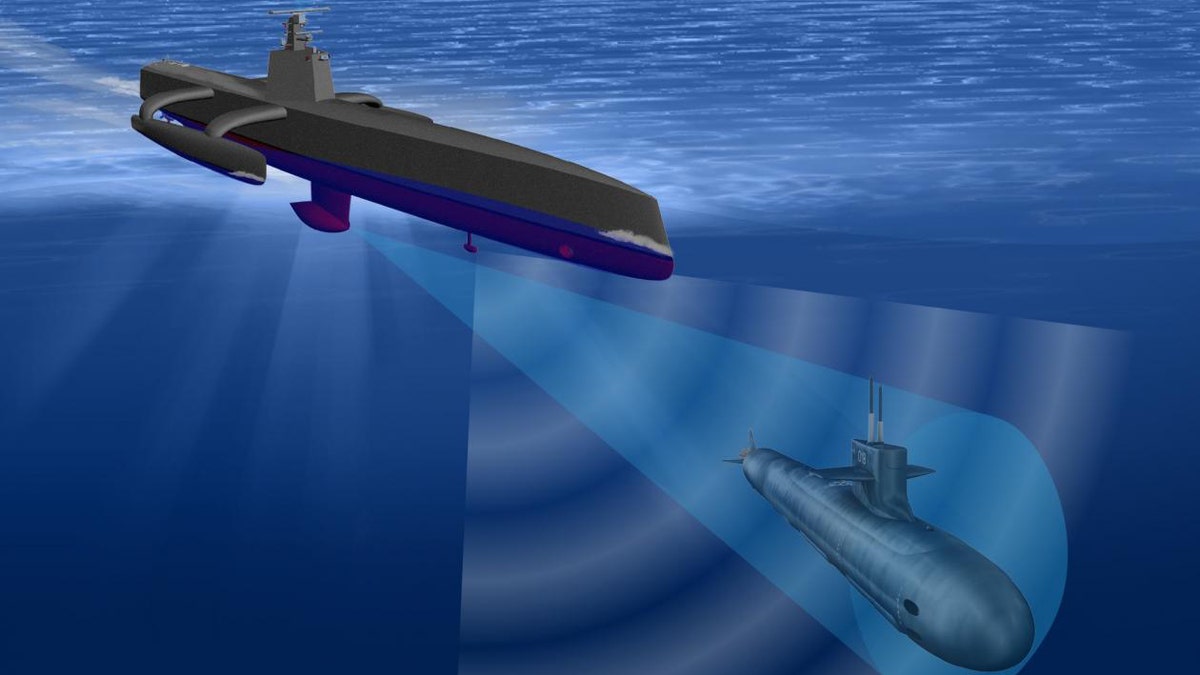
DARPA illustration of a Sea Hunter drone. (DARPA)
A coordinated fleet of Navy drone boats could test and penetrate enemy defenses, launch forward-operating attacks across large areas of ocean, clear mines, attack submarines and use emerging AI to rapidly adjust to changing war circumstances.
Perhaps of utmost significance, a large fleet of integrated surface and undersea drones can network to one another, massively expanding the reach and effectiveness of sensors, weapons and air-sea coordination. This kind of desired tactical advantage forms the basis for the Navy’s Ghost Fleet Overlord project, a multi-year technical initiative to engineer a “fleet” of coordinated unmanned systems, intended to give warzone decision-makers crucial combat sensitive information amid life-threatening, dangerous exchanges of fire.
It is within this war context that the Navy is accelerating as many as seven new prototype Unmanned Surface Vessels (USV) to the fleet over just the next few years.
PENTAGON DEPLOYS NEW SUB-LAUNCHED, LOW-YIELD NUCLEAR MISSILE
The now on-the-way drones include two large submarine-hunting Sea Hunter drones, four vessels designed to support Overlord and one new Medium USV, Navy weapons developers said.
“The reason we need these vessels is to demonstrate a number of different autonomy technologies and a variety of different payloads envisioned. We also need to match fleet CONOPs (Concepts of Operations) that employ multiple USVs operating in proximity with each other,” Capt. Pete Small, unmanned systems program manager, Naval Sea Systems Command, said in a presentation at the 32nd annual Surface Navy Association Symposium, Arlington, Va.
The seven prototypes, slated to arrive over the next few years, are part of a broad Navy effort to add large numbers of surface and undersea drones to the fleet -- quickly.
NAVY ARMS SEA DRONES FOR OCEAN ATTACK
“We will also need them [the prototypes] to develop the thousands of hours of water time and testing we will need to develop autonomous behavior of these vessels,” Small said.
Development of the new Ghost Fleet Overlord drones has been a multi-year project involving the Office of Naval Research, Naval Sea Systems Command and DARPA, the Pentagon’s research arm. Autonomy and human-led command and control systems form the basis of the evolving technical progress, which is woven into an existing Navy program called Unmanned Maritime Autonomy Architecture (UMAA), Small said. The service is now working on new technically detailed Interface Control Documents, intended to bring this vision to fruition.
“Overlord is command and control that we envision operating on all of our USVs,” Small said.
NAVY TESTS NEW SLEEK, STEALTHY DESTROYER HULL IN ROUGH SEAS
While preparing to arm the maritime drones with weapons, Small explained that the initial focus for the new, larger surface drones will be autonomy, endurance, precision navigation and command-and-control.
Of greatest significance, Small explained, is that the prospect of large numbers of interwoven, armed surface drones introduced an entirely new sphere of Tactics, Techniques and Procedures. These surface drones, operating in tandem with surface ships, undersea drones, aerial drones and submarines, promise to change the character of maritime warfare.
USVs could help foster an impactful cross-domain tactical option which linked air, surface and undersea assets into an integrated command and control network. Small said that developmental USV interface documents were focused on continued efforts to engineer a common control system able to connect Naval Sea Systems Command with Naval Air Systems Command.
A fast-growing fleet of USVs, it would appear, could bring the promise of greater forward-deployed command and control, along with an increased ability to integrate a range of otherwise separated functions. For instance, it seems entirely plausible that a new MUSV could combine submarine-hunting with mine-countermeasures, command and control and surface attack. As a forward-positioned vessel, it could enable deeper draft manned ships to operate at safer standoff ranges.
Also, by pushing the limits of technology, larger surface drones could potentially bring unprecedented amounts of endurance. Not only would they not need to constrain mission dwell time by a need to return human crews, but larger drones could potentially carry more fuel, supplies and ammunition.
CLICK HERE TO GET THE FOX NEWS APP
These missions also include things like perimeter security, wherein unmanned armed surface vessels are forward-deployed to identify and attack approaching targets, all while protecting larger ships such as Littoral Combat Ships or even Carrier Strike Groups and Amphibious Ready Groups.




















